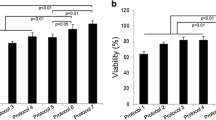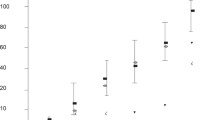Summary
The production of human chorionic gonadotropin (hCG), pregnancy-specific beta-1 glycoprotein (SP1), and the various placental tissue proteins (PP4, PP5, PP10, PP11, PP12, MP1) was examined in human choriocarcinoma cell lines using radioimmunoassay (RIA) and an immunoperoxidase (PAP) staining method. In 6 gestational and 2 nongestational choriocarcinoma cell lines, hCG was produced in vitro. A significant heterogeneity of hCG production was noted among the cell lines. Production of hCG in the xenograft tumors was consistent with the hCG production of the same cell lines in vitro. SP1 was demonstrated both in the culture supermatants and the xenograft tumors of 3 cell lines, and the production was found to be inversely correlated with the hCG production of the cell lines. Positive staining for PP4 and MP1, and weakly positive staining for PP5, PP10, and PP12 was found in the xenograft tumors by immunoperoxidase (PAP) stain, but the staining for PP11 was negative. These placental proteins showed positive staining in portions of choriocarcinoma cells. These results indicate that placental proteins are not equally produced in heterogeneous choriocarcinoma cells.
Similar content being viewed by others
References
Takamizawa H, Sekiya S (1984) Cell biology of choriocarcinoma: a brief review. Asia Oceania J Obstet Gynaecol 10:245–256
Hussa RO (1980) Biosynthesis of human chorionic gonadotropin. Endocr Rev 1:268–294
Tatarinov YS (1978) Trophoblast-specific beta 1-glycoprotein as a marker for pregnancy and malignancy. Gynecol Obstet Invest 9:65–97
Bagshawe KD (1983) Tumor markers—where do we go from here. Br J Cancer 48:167–175
Bohn H, Inaba N, Luben G (1981) New placental proteins and their potential diagnostic significance as tumor markers. Oncodevelop Biol Med 2:141–153
Nakamoto O (1980) Properties of strain cells of the uterine invasive mole and its metastatic choriocarcinomas. Asia Oceania J Obstet Gynaecol 6:177–189
Pattillo RA, Gey GO (1969) The establishment of a cell line of human hormone-synthesizing trophoblastic cells in vitro. Cancer Res 28:1231–1236
Suzumori K, Sugimoto Y, Suzumori K, Yagami Y, Takeda A (1983) The establisment of human choriocarcinoma cell line in vitro. Asia Oceania J Obstet Gynaecol 9:309–315
Pattillo RA, Ruckert A, Hussa RO, Bernstein R, Delfs E (1971) The Jar cell line. Continuous lines of human chriocarcinoma. In Vitro 6:398–399
Kohler PO, Bridson WE (1971) Isolation of hormone-producing clonal lines of human choriocarcinoma. J Clin Endocrinol Metab 32:683–687
Sekiya S, Shirotake S, Kaiho T, Iwasawa H, Kawata M, Higaki K, Ishige H, Takamizawa H, Minamihisamatsu M (1983) A newly established human gestational choriocarcinoma cell line and its characterization. Gynecol Oncol 15:413–421
Sekiya S, Kaiho T, Shirotake S, Iwasawa H, Inaba N, Kawata M, Higaki K, Ishige H, Takamizawa H, Minamihisamatsu M, Kuwata T (1983) Establishment and properties of a human choriocarcinoma cell line of ovarian origin. In Vitro 19:489–494
Oboshi S, Yoshida K, Seido T, Shimosato Y, Koide T, Sano R, Kitaoka K (1972) Culture of primary choriocarcinoma of stomach and its gonadotropin production in vitro. Proceedings of the 31st Annual Meeting of the Japan Cancer Association, p 59 (in Japanese)
Inaba N, Renk T, Bohn H (1980) Immunohistochemical location of placental proteins (PP8, 9, 10, 11, 12) in human term placentae. Arch Gynecol 230:109–121
Barki Y, Lee JH, jr, Jahshan AE, Lewis GC, jr (1982) Uterine choriocarcinoma with negative specific serum radioimmunoassay for human chorionic gonadotropins. Gynecol Oncol 14:112–118
Lemonnier MC, Glezerman M, Vauclair R, Audet-Lepointe P (1986) Choriocarcinoma associated with undetectable levels of human chorionic gonadotropin. Gynecol Oncol 25:48–52
Horne CHW, Rankin R, Bremner RD (1984) Pregnancy-specific proteins as markers for gestational trophoblastic disease. Int J Gynecol Pathol 3:27–40
Bagshawe KD, Lequin RM, Sizaret P, Tatarinov YS (1978) Pregnancy beta 1-glycoprotein and chorionic gonadotropin in the serum of patients with trophoblastic and non-trophoblastic tumors. Eur J Cancer 14:1331–1335
Westergaard JG, Sizaret P, Hindersson P, Folkersen J, Teisner B (1980) Pregnancy specific beta 1-glycoprotein (SP1) in patients with trophoblastic disease: molecular heterogeneity and a SP1 consuming factor? Acta Pathol Microbiol Immunol Scand [C] 88:233–236
O Brien TJ, Engvall E, Schlaerth JB, Morrow CP (1980) Trophoblastic disease monitoring: evaluation of pregnancy-specific glycoprotein. Am J Obstet Gynecol 138:313–320
Sakuragi N (1982) Serum SP1 and hCG β-subunit (hCGβ) levels in choriocarcinoma, invasive mole, and hydatidiform mole-clinical sïgnificance of SP1/hCGβ ratio. Gynecol Oncol 13:393–398
Szymendera JJ, Ploch E, Zalucka K, Sikorowa Z, Kaminska JA, Gadek A (1986) Gestational trophoblastic diseases: the ratio of choriogonadotropin to specific pregnancy protein, hCG/SP1, provides useful diagnostic and prognostic evidence. Gynecol Oncol 23:149–159
Inaba N, Ishige H, Ijichi M, Satoh N, Katoh T, Sekiya S, Shirotake S, Ohkawa R, Takamizawa H, Nitoh A, Renk T, Bohn H (1982) Possible new markers in trophoblastic diseases. Am J Obstet Gynecol 143:973–974
Seppälä M, Wahlström T, Bohn H (1979) Circulating levels and tissue localization of placental protein five (PP5) in pregnancy and trophoblastic disease: absence of PP5 expression in the malignant trophoblast. Int J Cancer 24:6–10
Than GN, Bohn H, Csaba IF, Szabó DG, Karg NJ, Göcze P (1981) Placental proteins (SP1, hCG, PP5) and α2PAG in trophobalstic diseases. Arch Gynecol 231:33–39
Nisbet AD, Bremner RD, Horne CHW, Brooker D, Twiggs LB, Okagaki T (1982) Placental protein 5 in gestational trophoblastic disease: localization and circulating levels. Am J Obstet Gynecol 144:396–401
Lee JN, Salem HT, Chard T, Huang SC, Ouyang PCO (1982) Circulating placental proteins (hCG, SP1 and PP5) in tropoblastic disease. Br J Obstet Gynaecol 89:69–72
Tsakok FHM, Koh S, Chua SE, Ratnam SS, Teisner B, Jones GRD, Sinosich M, Grudzinskas JG (1983) Prognostic significance of the new placental proteins in trophoblastic disease. Br J Obstet Gynaecol 90:483–486
Author information
Authors and Affiliations
Rights and permissions
About this article
Cite this article
Sekiya, S., Inaba, N., Ishige, H. et al. In vitro and in vivo studies of the production of placental proteins (HCG, SP1, PPs) in human choriocarcinoma cell lines. Arch Gynecol Obstet 241, 111–120 (1987). https://doi.org/10.1007/BF00931231
Received:
Accepted:
Issue Date:
DOI: https://doi.org/10.1007/BF00931231




